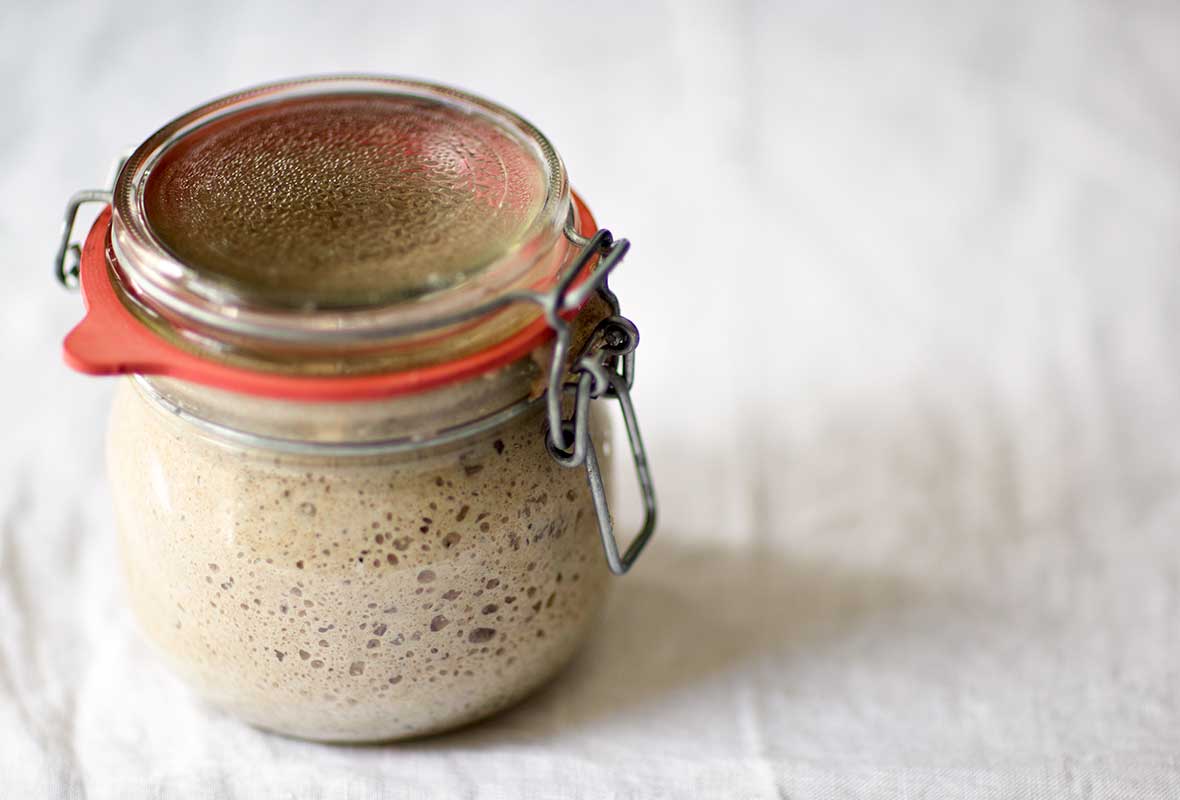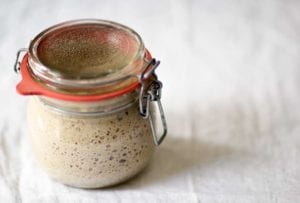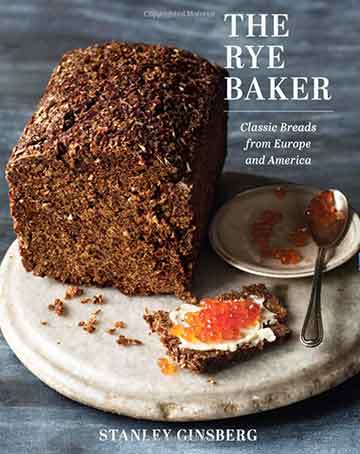
It’s not hard to make a rye sourdough starter from scratch. Some sourdough starters rely on wild yeasts that live in the air, others on acid-producing bacteria present in buttermilk, yogurt, pineapple juice, and the like, and still others start with commercial yeast or store-bought starters. Fact is, none of these additives is necessary. All it really takes to build a delicious and robust rye sour culture, or starter, is some whole-grain rye flour, water, a warm place, and patience. [Editor’s Note: And when your traditional rye sourdough starter is complete, the very first thing you’re going to want to do is use it to make this Galician rye bread.]–Stanley Ginsberg
☞ LEARN MORE, READ: HOW TO DRY SOURDOUGH STARTER

Rye Sourdough Starter
Ingredients
Day 1: Make the Rye Sourdough Starter
- 2.5 ounces whole grain rye flour, preferably organic
- 2.5 ounces warm water (105°F or 41°C)
Days 2 to 7: Refresh the Rye Sourdough Starter
- 2.5 ounces whole grain rye flour, preferably organic
- 2.5 ounces warm water (105°F or 41°C)
- 2.5 ounces Sour Starter from the preceding day
Days 8 and Beyond: Maintain the Rye Sourdough Starter
- 2.5 ounces medium or whole-grain rye flour, preferably organic
- 2.5 ounces warm water (105°F or 41°C)
- .25 ounces rye sourdough starter
Instructions
Day 1: Make the rye sourdough starter
- Start with equal amounts of organic rye flour and water by weight. Dump them in a nonreactive (glass, porcelain, stainless-steel, plastic) container, mix by hand into a stiff paste, cover, and let stand at room temperature (68 to 72°F or 20 to 22°C) for 24 hours.
☞ TESTER TIP: Occasionally the yeast normally present in whole grains fail to establish itself in a new culture; if, after 3 or 4 days, the culture darkens, develops a mold, or smells bad, dump the whole batch and start over. After a week, the culture, or sourdough starter, will be ready to use or to be stored refrigerated in an airtight container for a couple days. [Editor's Note: If storing the sourdough starter for more than a couple days, you'll need to maintain it, which we explain how to do just below.]
Days 2 to 7: Refresh the rye sourdough starter
- The next day, discard all but 2 1/2 ounces (70 grams) of the culture and mix the remainder with the refresh ingredients, cover, and let stand. Repeat each day, discarding all but 2 1/2 ounces (70 grams) of the preceding day’s culture.
☞ TESTER TIP: The most important point to remember at the early stages is to feed the sourdough starter daily. Even when it shows no apparent fermentation, the yeast is busy multiplying and consuming nutrients at a very high rate. By the second or third day, it will swell, show bubbles, and give off a clean sour smell. Over the next few days the activity will become more and more vigorous and the smell more intense.
Days 8 and Beyond: Maintain the rye sourdough starter
- In a perfect world—or in a working bakery—sourdough starters are refreshed daily. That said, daily feedings demand both a degree of dedication and abundant flour supplies that are impractical for all but the most committed home bakers. You can get by refreshing your starter every 36 hours or so.
- Mix the rye flour, water, and rye sourdough starter by hand until incorporated. Cover and ferment at room temperature (68 to 72°F or 20 to 22°C) overnight or for 10 to 12 hours. The sponge will be very bubbly, have a clean sour smell, and will have tripled in volume. Store refrigerated in an airtight container and it will last indefinitely.

Nutrition
Nutrition information is automatically calculated, so should only be used as an approximation.
Recipe Testers’ Reviews
The rye starter was easy to make and quick. It took about 5 minutes each of the 7 days. Mine smelled great and seemed consistent after the week of feedings. I switched to the refresh amounts after that and it stayed nice and healthy.
During the buildup, you end up tossing about 2/3 of it away. I definitely recommend a scale versus just using volume measurements.










Hello David! Can you use the rye sourdough starter for just plain sourdough bread? I’ve been reading about how to create a starter and most just use AP flour. All the options and reading about starters, are a bit intimidating! Any advice for a beginner? Thank you!!
Wendy, I use a 100% rye stater for all my sourdough bread, regardless of the type of loaf–tye, plain, pumpernickel. So, march on!
Hello! In step 4 it says the starter will keep indefinitely, but the previous step says you have to feed it every 3 days. Is there any way to keep the starter for future use if you expect a long time to pass before you use it again?
Sherry, you do need to feed it to keep it indefinitely. (It’s kind of like kids…they’ll stay around, but you need to feed them!) If I’m not planning to bake for a while, I’ll feed mine once a week then when I want to use it, I make sure to feed it once a day for two or three days prior to wake it and strengthen it.
Thank you! One more question–I was only able to find dark rye in the store…will that mess up the recipe?
Sherry, it should be perfectly fine.
I just used a cup of my starter remnant to make biscuits, and am using the rest to make crackers tomorrow. You really don’t have to throw it away!
Brilliant, Mary. Can you tell me more about how you used the starter for biscuits? Do you recall the amounts or proportions of ingredients that you used?! We’re so curious to try this in our kitchens!
Hi, Renee, a friend pointed me to this recipe for “regular” sourdough starter, which is much more liquid than all-rye starter:
and since the quintessential biscuit requires cutting the ingredients together with two knives or two forks or a pastry cutter, it’s easy with the softer wheat starter. The rye starter remnant is so heavy and stiff that it took a lot of upper-body strength to cut it all together by hand, and I wish someone would invent an electric pastry cutter! A mixer even with a dough hook won’t do since small pieces of butter are essential to the rising. But if you’re willing to invest the time and elbow grease, the taste is delicious with either sweet or savory toppings.
Thanks so much, Mary. Greatly appreciated. And yes, perhaps with the extra time lately, you could create that.